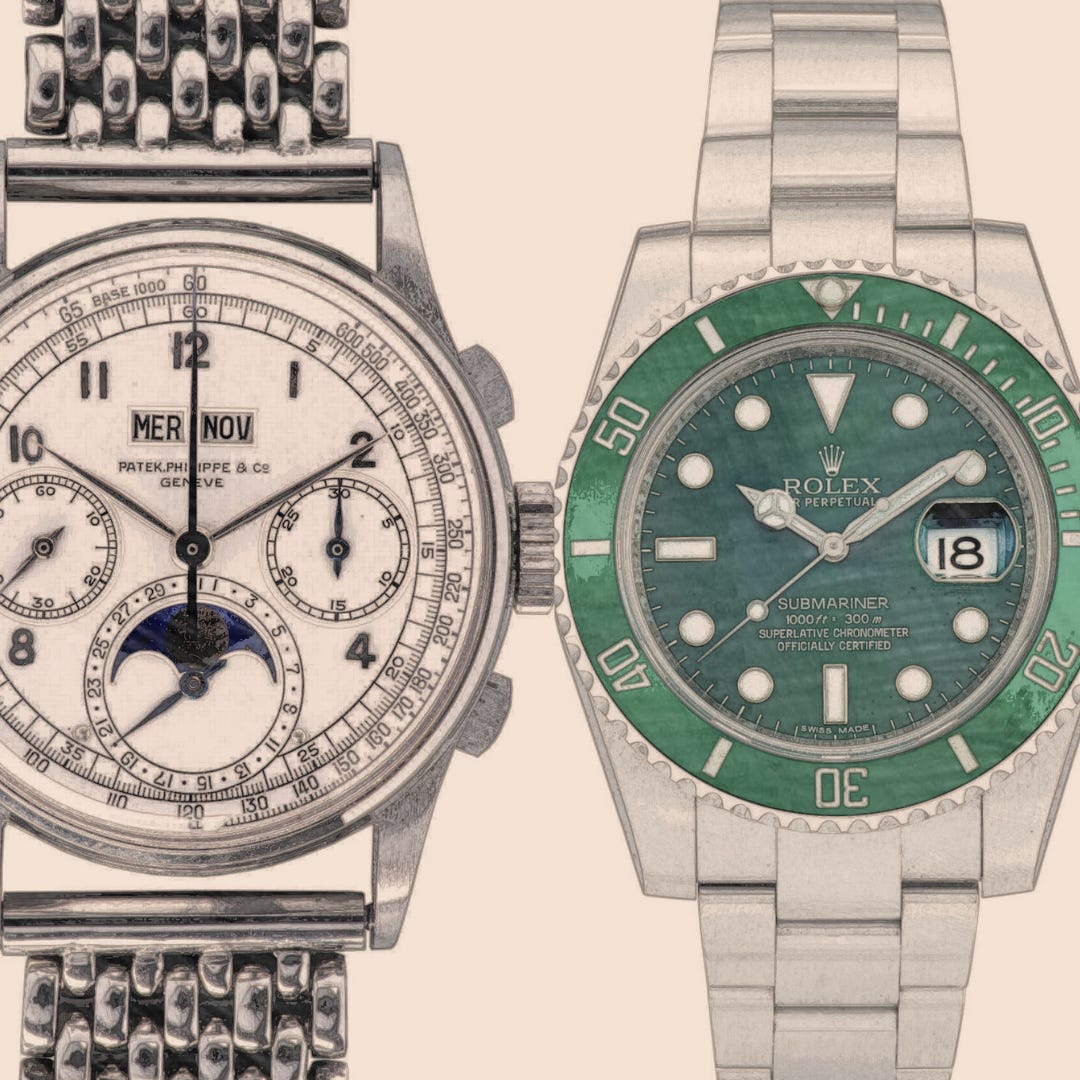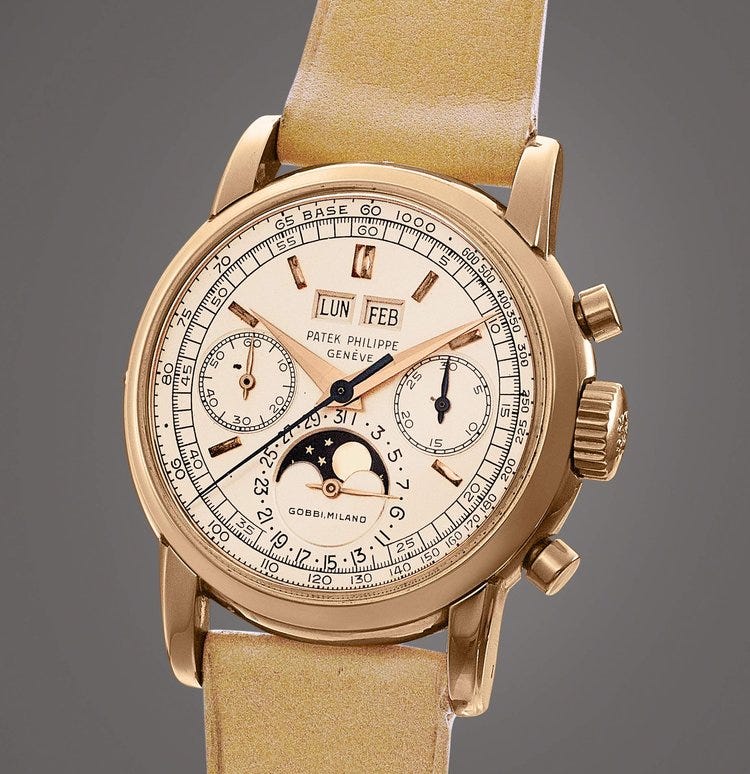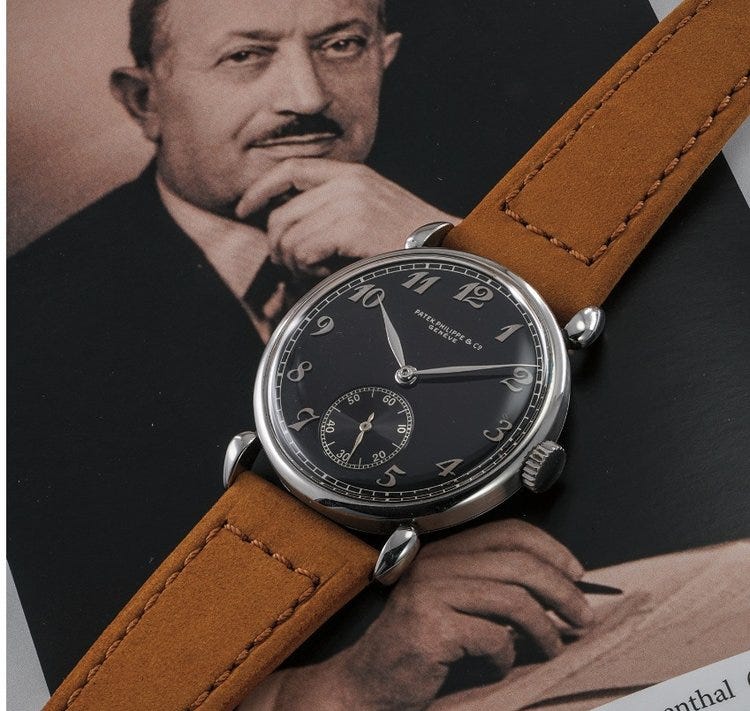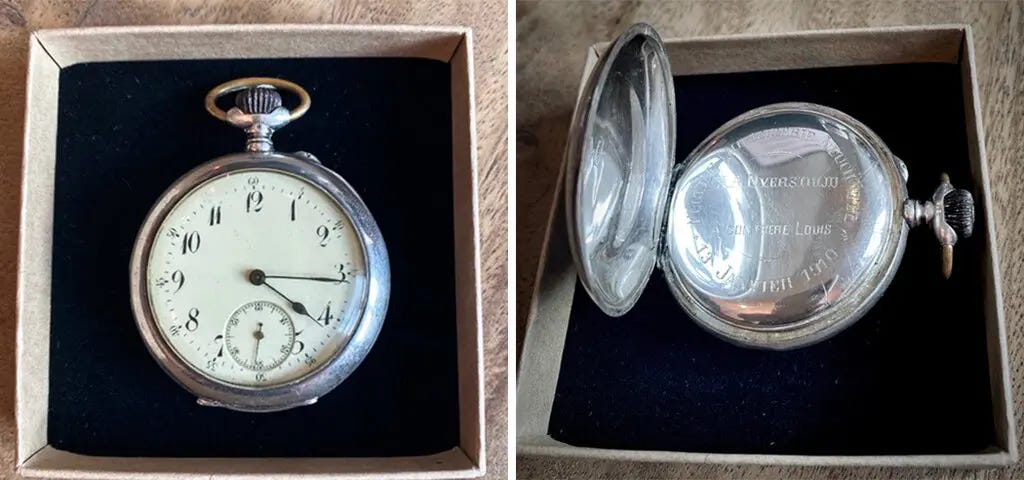Happy Tuesday. This article is the coolest explainer I’ve ever seen of how a mechanical watch works, complete with 100+ interactive images to illustrate every single component of the watch.
We’re in the middle of auction season, so we take a minute to talk trends, also looking at 11 of the biggest results so far this year. Then, a roundup of links that tell the story of a Nazi-stolen watch, watch YouTubers, rare Pateks, and more.
I’ve had a number of watches in for hands-on looks over the past few weeks (Tudor, AnOrdain, Nomos all coming soon) and I’m still editing photos and writing these up, so this week’s ‘sletter is more casual and rec-driven than others. Tap that heart if you like the format.
Investor? I Hardly Know Her
Watches have been a great investment over the past decade or so, according to guys like Kevin O’Leary at least. The money-making gambit has focused in particular on the modern hype watches from Rolex, etc. And if you look at auction results from the past week, it seems like the rocket ship is still flying irrationally close to the sun for some of these watches.
I could point to any number of lots, but the two most egregious examples are probably this “Tiffany Blue” Rolex Oyster Perpetual and this modern Rolex Daytona, both of which sold for CHF 69,300 at Christie’s; crazy numbers for watches that retail (past tense, in the case of the retired Oyster Perpetual) for around ten grand.
But now, people are starting to talk about a “market correction,” a term that must’ve been invented just for people to shout during CNBC segments.
I don’t follow the price of, say, the Hulk Submariner closely enough to know if there’s been a market correction in the past couple of weeks. But anyone who’s not clearly delusional knows that a graph that looks like this is about as sustainable as mining Bitcoin (Chrono24’s price graph for the Hulk):
I’m an enthusiast collector and not really an “investor,” but we all know these modern hype watches haven’t really traded on their fundamentals for a few years now. In fact, a working definition of “hype” that’s probably as good as any might be something like “the portion of a watch’s price which can’t logically be attributed to, well, anything.” Here’s a graph of modern Nautilus prices to illustrate:
Now, if you knew calculus, you could use some derivatives to calculate the area under the curve, truly quantifying the hype. But the best quantification I’ve heard is this: in 2017, one-third of all Billboard Hot 100 songs mentioned Patek Philippe.
We’ve talked about this on our Significant Watches Podcast before — the Nautilus 5711 was produced for 15 years and Patek probably made tens of thousands of them. It makes absolutely no sense that an objectively not rare watch would sell for 10x its MSRP.
This brings me to my point. While these hype watches haven’t been trading on fundamentals, many watches, including some of the biggest results of the year so far (full article below) do trade on fundamentals. For example, the five biggest results are all vintage Patek Philippe Perpetual Calendar Chronographs.
While everyone’s been going crazy about modern this or that, vintage watches from Patek, Rolex, and others have kept slowly plodding along.
Take a look at the biggest result of the year so far: The Gobbi-signed Patek Philippe 2499 in pink gold, selling for ~$7.7m. The Gobbi 2499 set a world record for the reference, of which Patek only produced 349 examples. It’s an obscene amount of money for a watch, to be sure (but, less obscene than paying $70k for a modern Daytona, I’d argue).
The collector who sold the Gobbi 2499 bought it back in 2007 for CHF 2.7m, also a record for the reference at the time. So sure, the “investment” nearly tripled, but over fifteen years. Not overnight (see the Hulk, above) — it’s more like an 8 percent annual return.
So sure, maybe there will be a “market correction” in some of the mass-produced modern watches that have seen ridiculous markups over the past few years. But that shouldn’t affect every watch.
Many watches have kept on trading on the fundamentals: rarity, condition, provenance. The things real collectors, not investors, care about.
The 11 Biggest Watch Auction Results from a Crazy Season
With that, let’s take a closer look at the biggest auction results of 2022 so far.
My favorite? It might be number 11 on the list. This Patek Philippe is nicknamed “the Wiesenthal” because it was likely once owned by Holocaust survivor and human rights advocate Simon Wiesenthal.
After World War II, Wiesenthal dedicated his life to tracking down and gathering information on fugitive Nazi war criminals so that they could be brought to trial.
In John Goldberger’s book Patek Phillipe Steel Watches, there is a picture of Mr. Wiesenthal at his desk, wearing a teardrop-lug timepiece which is most likely this reference 1503. Getty Images also has an image of him wearing it.
As for the watch itself, it’s rare too: only one other example of this reference is known with black lacquered dial and Breguet numerals. The Wiesenthal sold for CHF 1.36m at Phillips.
THROUGH THE WIRE
📝 A Nazi Soldier Stole a Watch in 1942. It Turned Up 80 Years Later.
“The pocket watch was crafted in 1910 by Alfred Overstrijd, a Jewish man from the Dutch city of Rotterdam who was then learning to be a watchmaker. He made it as a gift for his brother, Louis, for his 18th birthday. An inscription on the back of the watch includes Mr. Overstrijd’s name and the place and time it was made as well as the fact that it was intended for his brother. In 1942, Louis Overstrijd was arrested by the Nazis, at which point it’s likely that a soldier took the watch from him, or from his house.” (NY Times)
🎥 YouTubers Are Schooling Rolex on How to Talk About Watches.
“Like fans of other high-end kit favored by men of a certain age — think espresso machines, racing bikes or bespoke tailoring — watch aficionados can come off as fussy and stilted. [YouTuber Adrian Barker (Bark & Jack)], by contrast, appears equally at ease discussing his first timepieces — “absolutely foul” — as he does fawning over his current Rolex Explorer II, which retails for about $9,000. It’s all delivered in a rapid-clip narration that’s both disarming and dissecting.” (Bloomberg)
🧨 Inside the Disruptive Startups Selling Pre-owned Luxury Watches. A look at A Collected Man, Subdial, and Delray Watch, three online-first pre-owned resellers, including a quote from McKinsey & Co. that I agree with: “‘Platforms that are able to take on the inventory risk because they understand the market, the pricing and are confident they can sell it on,’ says McKinsey’s Anita Balchandani. ‘It’s a model that’s going to win out.’” Acquiriting inventory and authenticating it is expensive, but it’s totally necessary in an industry where one of the most-repeated axioms is to “buy the seller.” (Vogue Business)
🎧 Significant Watches Ep. 14: Churchill's Lost Watch, Geneva Watch Auctions and Patek 'Dore' Dials
The horology homies are back to discuss the Geneva watch auctions, including all of the Royal Oaks for sale, plus Rolex, Patek, and more. Before getting down to business though, Eric Wind treats us to storytime. Finally, we nerd out on vintage Patek, sucked in by the warm embrace of its luscious, golden “dore” dials.
🦪 John Reardon shows his latest find, the third-known “Pearl of Bahrain”. This example is yellow gold, with a beautiful Gay Freres bracelet; the first two “Pearls” found were rose gold (one sold for $437k in 2015, one for $250k in 2018).
🎶 References to watches I’ve heard on Kendrick Lamar’s new album:
“I bought a Rolex watch, I only wore it once / I bought infinity pools I never swimmed in” — United in Grief
“AP, Michael Friedman, my friends cooler / Primary, so the resale value stupid” — Rich Spirit
🔨 The Best Watch Tools on Amazon You Should Actually Buy. 🅰️ “Yep, I created the new Avatar font.”










